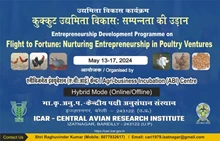
The dairy sector plays a crucial role in India's agricultural sector, contributing significantly to milk production. The country is the world's top producer of milk, accounting for 24.64 percent of the total. Approximately 96% of India's total milk output comes from cattle and buffaloes which are well-known for producing milk. Over the last nine years, milk output has increased at a Compound Annual Growth Rate (CAGR) of 5.85%, from 146.31 million tonnes in 2014–15 to 230.58 million tonnes in 2022–2023. Further, the government intends to raise this share to 30% by 2030.
If there is an ideal balance between fertility and productivity, this goal will be accomplished. However, heat stress-induced productivity losses amount to a substantial economic burden, underscoring the urgency of effective mitigation strategies. This article explores the various aspects of heat stress management, its economic implications, and mitigation strategies in the dairy industry.
Heat stress poses significant challenges to the reproductive performance of dairy cattle and buffaloes. With the dairy sector being particularly susceptible to the effects of global warming and climate change, it becomes crucial to assess and mitigate the adverse impacts of heat stress on these animals.
The economic impact of heat stress on livestock is substantial. In India, heat stress among cattle and buffaloes results in a loss of 1.8 million tonnes of milk annually, amounting to roughly Rs. 2661 crore. Factors such as inadequate nutrition, poor management practices, and environmental conditions significantly contribute to reduced reproductive efficiency in cattle.
Significance of Temperature Humidity Index (THI)
The Temperature Humidity Index (THI) is a vital tool for quantifying the extent of heat stress experienced by animals. Elevated THI levels have been linked to reduced fertility in dairy cattle and buffaloes, primarily due to its detrimental effects on oocyte maturation and early embryo development.
Management Strategies for Mitigating Heat Stress
To counteract the negative consequences of heat stress, specific management strategies must be put in place. These include:
-
Nutrition Modification: Optimizing nutritional intake tailored to combat heat stress can bolster reproductive outcomes. Adequate supplementation and dietary adjustments play a pivotal role in maintaining fertility levels.
-
Environment Modification: Implementing measures such as shade provision, sprinkler systems, and ventilation improvements within housing facilities mitigate the impact of elevated temperatures on livestock.
-
Timed Artificial Insemination Protocol: Precision timing of artificial insemination procedures synchronized with heat stress patterns enhances conception rates, mitigating the adverse effects on fertility.
Identifying genes associated with heat tolerance and incorporating them into breeding programs is essential for enhancing the resilience of dairy animals to heat stress. Additionally, integrating THI covariate effects into selection indices can improve the genetic evaluation process, thereby facilitating the development of heat-tolerant dairy breeds.
Government Initiatives
Animal husbandry falls under state jurisdiction, with governmental agencies supplementing state efforts through various schemes. Disaster Management Authorities at the state level are tasked with developing comprehensive plans to address livestock vulnerabilities during natural disasters, including heat waves, droughts, and floods. Key measures include:
-
Conducting awareness programs and veterinary care initiatives.
-
Establishing disaster-resilient infrastructure and logistical support systems.
-
Enhancing disease diagnostic and control measures.
-
Implementing animal camps and rehabilitation initiatives.
Heat Management Practices
Efficient heat management practices are crucial for safeguarding animal welfare and productivity. These include:
-
Providing access to cool water and shade.
-
Adjusting milking schedules to avoid peak heat hours.
-
Implementing nutrition and environment modifications.
-
Educating stakeholders on heat stress prevention and management.
Dos and Don'ts of Heat Stress Management
Effective heat stress management requires adherence to specific guidelines:
Dos:
-
Regularly monitor local weather forecasts.
-
Ensure access to cool water and balanced feed.
-
Utilize sprinklers and shade in holding yards.
-
Provide additional feed to pregnant animals.
Don'ts:
-
Leave animals tied in direct sunlight.
-
Overcrowd animal shelters.
-
Conduct animal movements during peak heat hours.
-
Discard animal carcasses in grazing routes.
Cooperation between sectors, including agriculture, veterinary services, and disaster relief agencies, is essential for implementing holistic strategies to mitigate heat stress. Engagement with local stakeholders, NGOs, and community leaders fosters awareness and resilience-building efforts. Furthermore, the deployment of Mobile Veterinary Units (MVUs) facilitates on-the-ground interventions and emergency response capabilities.
Proactive measures, informed decision-making, and stakeholder engagement are essential for effectively addressing the challenges posed by heat stress in the dairy sector. By prioritizing heat stress management, stakeholders can ensure the sustainable growth and resilience of India's dairy sector amidst changing climatic conditions.










